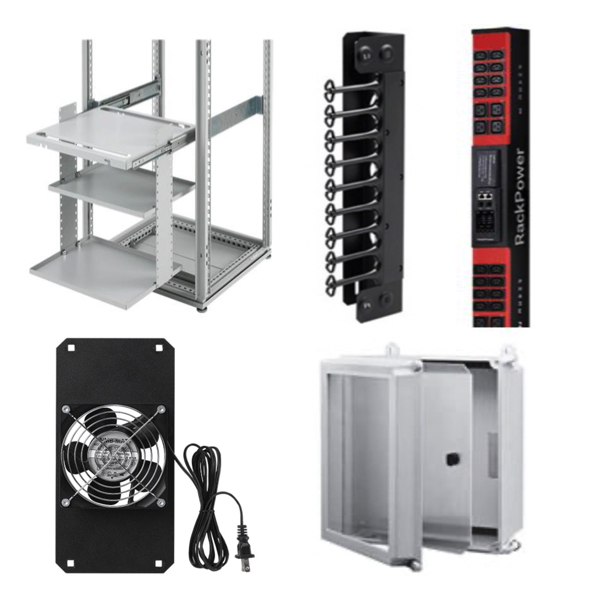Network Frames, Racks & Accessories

Network frames, often referred to as open frame racks, are structures designed to support network equipment in environments like data centers. Unlike enclosed network cabinets, these frames typically lack side panels and doors, facilitating easy access and efficient cable management for high-density networking equipment such as servers, switches, patch panels, and routers. The open design promotes better airflow, which is crucial for cooling the electronic equipment.
These racks are measured in rack units, with the height of the equipment intended for mounting expressed in multiples of 1.75 inches or one rack unit. The absence of doors and side panels on network frames means that equipment can be mounted and accessed from all sides, making maintenance tasks simpler and quicker.
Server racks within these frames are structured to hold heavier equipment securely, while lighter equipment also finds ample support. The racks can accommodate various types of mounting, including 2-post and 4-post configurations; the 2-post style is more suited to lightweight equipment, while the 4-post design can handle the greater depth and weight of servers and larger devices.
More Information about Network Frames, Racks and Accessories
Wall mount options provide a space-saving solution for smaller devices or when floor space is at a premium, whereas floor-standing frames offer a more traditional setup with the capacity to hold a greater number of devices. These frames can be used with cage nuts and mounting screws to secure devices in place, allowing for adjustments to the depth and width to suit the variety of sizes that equipment comes in.
The strength and stability of the frame are paramount, especially in a high-capacity, dynamic environment. Cable management accessories can be added to organize and protect cables, ensuring that the open nature of the frame does not lead to disordered cabling systems.
Brands like APC, Eaton, and Tripp Lite are renowned for supplying high-quality network frames that can be adapted to a range of uses, from the light-duty needs of a small office to the robust demands of a large-scale data center. When selecting a network frame, it is important to consider the size of the equipment, the environment in which it will be placed, and the potential for expansion to ensure that the chosen frame will work for the current and future needs of the network.
Easy to assemble and often requiring less material than enclosed cabinets, open frames can also be a cost-effective option for mounting network equipment. It is always recommended to check the specifications from the manufacturer, like Chief Manufacturing or IBM, to ensure that the frame will support the intended load and that it meets the necessary standards for safety and compatibility.
FAQs
What is the difference between a network rack and a server rack?
A network rack is typically used to house networking equipment such as switches, routers, patch panels, and related components, often featuring a two-post or open frame design that allows for easy access and connectivity. A server rack is generally enclosed with a four-post design, deeper shelving, and stronger construction to accommodate the heavier weight and required airflow of servers. While network racks focus on connectivity and access, server racks emphasize support, security, and thermal management for high-performance hardware.
What is the difference between a wall mount and surface mount network racks?
Wall mount network racks are designed to be attached directly to the wall, saving floor space and providing a secure, elevated position for networking equipment. They are ideal for smaller setups or environments where floor space is limited. Surface mount network racks, on the other hand, sit on the floor and are not affixed to the wall. They can typically handle heavier loads and offer more versatility for expansion but require sufficient floor space in the installation area.
Industrial Enclosures Accessories and Modifications
Common modifications or accessories that are used to enhance electrical cabinets.
Lighting kits
Lighting kits are often used in outdoor applications. There are many different styles of lighting kits that can be used, but LEDs have become the preferred lighting solution in the past several years.
Pressure switches
Pressure switches operate on a spring and react to the cabinet door opening and closing. They can be used for lights, intrusions alarms and exhaust fans.
Passive air vents
Passive air vents allow natural air circulation to flow through a cabinet providing proper ventilation.
Enclosure fans
Enclosure air fans are used when more ventilation is required. The size of the fan will depend on the size of the enclosure as well as the amount of air that needs to be circulated.
Air conditioners
Air conditioners are used when ambient air circulation is inadequate to cool the cabinet. The air conditioner size will depend on the enclosure size, ambient air temperature and heat generated within the cabinet.
Heaters
Heaters are used when a cabinet is located in areas that may be exposed to cold temperatures.
Locking mechanisms
Locking mechanisms are used to secure cabinets.
Conduit hole seals
Conduit hole seals are used on cabinets that have holes that need to be plugged after conduit has been removed.

